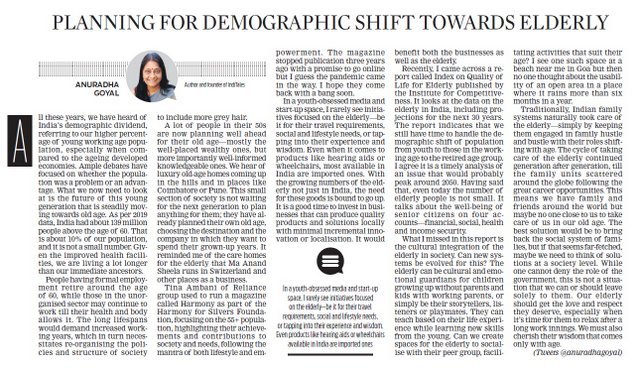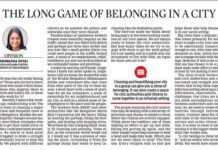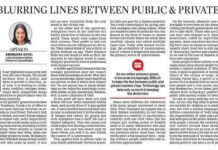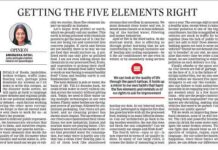This article Planning India’s demographic shift towards Elderly by Anuradha Goyal, author, and founder of IndiTales.com was first published by the New Indian Express newspaper on December 06, 2021.
All these years, we heard of India’s demographic dividend, referring to our higher percentage of the young working-age group population, especially when compared to the aging developed economies. Ample debates argued for and against population being a problem or an advantage. What we now need to focus on is the future of this young generation that is steadily moving towards old age. As per 2019 data, India had about 139 million people above the age of 60. That is about 10% of our population, and it is not a small number. Given the improved health facilities, we are living a lot longer than our immediate ancestors.
Plan for India’s Demographic shift towards elderly
People in the organized sector move out of formal employment around the age of 60, while those in unorganized may continue to work till their health and body allow. The long lifespans would demand longer working years that in turn necessitates re-organizing the policies and structure of the society to include more grey hair.
Planning for Old age
A lot of people in their 50s are now planning ahead well for their old age. Mostly the well-placed wealthy ones. But more importantly well informed knowledgeable ones. We hear of luxury old age homes coming up in the hills and in places like Coimbatore or Pune. This small section of society is not waiting for the next generation to plan anything for them. They have planned well for their own old age, choosing the destination and the company in which they want to spend their grown-up years. It reminded me of the care homes for the elderly that Ma Anand Sheela runs in Switzerland and other places as a business.
Tina Ambani of Reliance group used to run a magazine called Harmony as part of Harmony for Silvers Foundation. That used to focus on the 55+ population, highlighting their achievements, contributions to society, and their needs, following the mantra of both lifestyle and empowerment. The magazine stopped publishing 3 years ago with a promise to go online. But I guess the pandemic came in the way. I hope they come back with a bang soon.
Youth Obsessed
In a youth-obsessed media and start-up space, I rarely see initiatives focussed on the elderly. Be it for their travel needs, their social and lifestyle needs. Or even our need to tap into their experience and wisdom. Even when it comes to geriatrics products like hearing aids or wheelchairs, most of the products available in India are imported ones. With the growing numbers of elderly not just in India, the need for these products is bound to go up. It is a good time to invest in businesses that can produce quality products and solutions locally with minimal incremental innovation or localization. It would benefit both the businesses as well as the elderly.
Quality of Life of Elderly
Recently I came across a report called Index on Quality of Life for Elderly, published by the Institute for Competitiveness. It looks at the data on the elderly in India including projections for the next 30 years. The report indicates that we still have time to handle the demographic shift of the population from youth to the working-age group to the retired age group. I agree it is a timely analysis of a problem that would probably be at its peak around 2050. Having said that, even today the number of elderly people is not small. It talks about the well-being of senior citizens on four accounts – financial, social, health, and income security.
Cultural integration of Elderly
What I missed in this report is the cultural integration of elderly in the society. Can new systems be evolved to let the elderly stay culturally integrated into society? They can be cultural and emotional guardians for children growing up without parents, with working parents having no time for children or simply their storytellers or listeners or playmates. They can teach based on their long-life experiences while learning new skills from the young. Can we create spaces for the elderly to socialize in their peer group facilitating activities that suit their age? I see one such space at a beach near me in Goa. But then no one thought about the usability of open space in a place where it rains more than six months a year.
Indian Family System
Traditionally, Indian family systems naturally took care of the elderly. Simply by keeping them engaged in family hustle and bustle with their roles shifting with age. The cycle of taking care of the elderly continued generation after generation. That is until the family units scattered around the globe followed great career opportunities. This means we have family and friends around the world. But maybe no one close to us to take care of us in our old age.
Solution for Demographic shift towards elderly
The best solution would be to bring back the social system of families. But if that seems far-fetched, maybe we need to think of solutions at a societal level. While one can not deny the role of Government, but this is not a situation that we can or we should leave solely to Government. Our elderly should get the love and respect they deserve. Especially when it’s time for them to relax after long work innings. We must also cherish their wisdom that comes only with age.

Edited for this online publication.









good article to ruminate over.